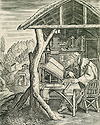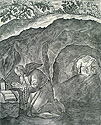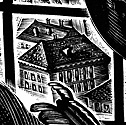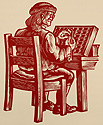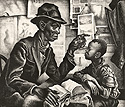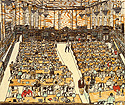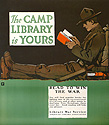Introduction
Reveries on Reading celebrates Lauinger’s 40-year mission in an era when digital media are transforming the process of reading and challenging the future of the book. The exhibition highlights the joy of reading and bibliophilia with images in fine prints, rare books and vintage posters in a broad range of periods and styles reflecting the rich diversity of the University Art Collection.
Throughout the exhibition, the calming presence of books and the intimate act of reading and reflection is depicted in a variety of individual and group settings, revealing the central role of reading in personal enrichment and in education.
Saints Anthony and Paul in a Cave
David Teniers the Younger (1610-1690)
Circa 1635
Oil on canvas
32 x 38 inches
Known primarily for his rustic genre scenes, the Antwerp painter David Teniers the Younger rose to a position of titled nobility as court painter to Archduke Leopold William in Brussels. His paintings became highly prized in the following century and were collected by royal patrons such as Catherine the Great of Russia, who owned twenty-two examples of his work. This painting depicts the story told by St. Jerome of St. Anthony’s visit to St. Paul, when the two hermits were miraculously fed by a raven bearing a loaf of bread.
Saint Joseph with Angel
Francesco Barbieri Guercino (1591-1666) (attributed)
Circa 1640
Oil on canvas
38 x 29 inches
Gift of Mrs. Nicholas Reggio
The subject of this painting is believed to be Saint Joseph since he was the only saint associated with a flowering staff, shown in the lower right corner of the composition. A story in the Protevangelium of James explains how Joseph was chosen to become Mary’s husband. According to this gospel, Mary’s suitors were asked to bring in their walking sticks and leave them in the temple overnight. By the next morning, the staff belonging to Joseph had blossomed with flowers, indicating divine favor.
The Cleric’s Interruption
Howard Helmick (1845–1907)
1881
Oil on canvas
29 x 37 inches
Art Collection purchase
This narrative painting by the American artist Howard Helmick depicts the moment when a young couple pay a surprise visit on their parish priest, presumably to ask him to marry them. Helmick studied at the École des Beaux-Arts in Paris under the famous classicist Alexandre Cabanel, and spent more than a decade in Ireland until 1887, where he painted dozens of genre scenes depicting the lives of the Irish working class. He later became Professor of Painting, Design and Art History at Georgetown. In 1895, Helmick painted a series of portraits of all but eight of the past presidents of the university.
Portrait of Egidio Forcellini (1688–1767)
Unidentified Artist
Undated
Engraving
The James C. and Mary G. Holland Print Collection of Historical Church Portraits
Egidio Forcellini was an Italian philologist who devoted his life to the assembling of the first Latin Lexicon (or Dictionary), which he labored on for some 35 years, but died eight years before its completion. Forcellini was born to a poor family from Treviso and entered seminary study in Padua. He was eventually ordained to the priesthood and served as both rector and father confessor at seminaries in Ceneda and Padua. The books on the shelves behind Forcellino in this engraving are presumably the volumes of his Lexicon.
Portrait of Roberto Bellarmino (1542–1621)
Unidentified Artist
Undated
Engraving
The James C. and Mary G. Holland Print Collection of Historical Church Portraits
The subject of this engraving is the Jesuit Cardinal Roberto Francesco Romolo Bellarmino, who was canonized by Pope Pius XI in 1930. Perhaps his greatest achievement was the multi-volume publication of the Disputations or Disputationes de Controversiis Christianae Fidei adversus hujus temporis Haereticos (1581–93). This work of dogmatics was a defense of papal power and the first attempt to systematize the religious controversies of the time. In this engraving the influential Cardinal is writing at his desk with an array of books on a ledge in the foreground. The unknown engraver reveals a wealth of detail, from the micromosaic portrait on the wall to the view of a church through the window.
Quinti Horatii Flacci Emblemata
Otto Van Veen (1556-1629)
Brussels: Franciscus Foppens
1683
Special Collections Research Center Rare Books Collections, From the library of Thomas Levins
The engraved plates in this emblem book, first published in 1612, are attributed to Gijsbert Van Veen (1558-1630), brother of the author. Among other distinctions, Otto Van Veen is known today as the teacher of his more famous pupil, Peter Paul Rubens. Below each engraved plate is a verse in French from Horace and other authors, with Latin and French glosses on the facing page.
Raccolta di Santi Padri nel Deserto
Giovanni Luigi Valesio (c. 1583-1633)
Bologna: Luigi Guidotti
1763
Special Collections Research Center Rare Books Collections
The 31 engraved plates in this rare volume depict the desert fathers and saints engaged in reading, praying, or some form of labor, each accompanied by a few lines of verse. The additional engraved frontispiece portrays Saint Lawrence.
The book is open to plate 2, showing Saint Anthony being tormented by curious looking demons. The one on the ground is nibbling on his garment while the smaller creature is poking his back with a stick. Other saints shown include: Evagrius, with spectacles; Paphnutius, reading outside; and Macharius, in a cave.
Saintes de France
Adelaïde Celliez (1801-1890)
Paris: Librairie de L’Enfance et de la Jeunesse, P.C. Lehuby
1853
Special Collections Research Center Rare Books Collections
The Rt. Hon. W. E. Gladstone
J. McLure Hamilton (1853-1936)
1898
Color lithograph
170 x 220 mm
Art Collection purchase
Four-time British Prime Minister William Gladstone, famously active and vigorous, is shown here in what must have been a rare moment of quiet study in the year after his retirement at age 84.
Bookshop
Earl Horter (1881-1940)
1933
Aquatint; 2,500 published
198 x 157 mm
Art Collection Purchase
Horter created this image for publication in The Colophon: A Book Collector’s Quarterly. At the time, The Colophon was still printed with high-quality original art prints alongside the text; soon afterwards, however, the financial pressures of the Depression forced a reduction in quality.
Giambatista Bodoni
Bernard Brussel-Smith (1914-1989)
Undated
Wood engraving
150 x 113 mm
Art Collection purchase
Master wood engraver Brussel-Smith here pays homage to two pioneers in book history. The innovations of Johannes Gutenberg (c. 1398–1468) allowed mass-production of printed matter, and thus made books more available to many more people than was previously possible. Giambattista Bodoni’s (1740–1813) technical mastery allowed him to design and produce hundreds of type faces during his career, and he is regarded today as the first to design letterforms based on mathematical proportions rather than the imitation of handwriting.
Brussel-Smith’s own technical ability can be seen in the enlargement, which represents just one square inch of the Bodoni print.
Ben Franklin, from the book Le Bon Docteur Franklin: The Toast of Paris
John DePol (1913-2004), illustrator, Charles V. Morris (d. 1983), editor
New York: privately printed
1970
Wood engraving
76 x 62 mm
Benjamin Franklin, shown here compositing type, believed strongly in the power of the press and was a vocal proponent of the free expression of ideas. He also formed the first public lending library in America, whose Latin motto translates to “To support the common good is divine.”
The Booklover
Hans Alexander Mueller (1888-1963)
Undated
Wood engraving
Approx. 65 x 90 mm
In contrast with the bustle of Davies’s Library below, Mueller’s five images here depict a largely solitary pursuit. These scenes are far from calm, however: staccato, decisive lines combine with forceful light-dark contrasts in presenting the book as an object of desire, and the experience of books and reading as high drama no less grand for its intimate nature.
Portrait of Lewis Alexander Buck
Arthur Smith (b. 1929)
1956
Sepia drawing
381 x 280 mm
James W. Elder Collection
The convention in portraits of showing the sitter with a book is meant to express the idea that the subject is educated or intellectual. Even more than the book “prop” in this extremely fine ink drawing, Buck’s direct and incisive gaze leaves the viewer in no doubt as to his intelligence.
Smith and Buck, both painters, have been friends and colleagues for over 60 years.
Instruction
Thomas Hart Benton (1889-1975)
1940
Lithograph; ed. 250
265 x 213 mm
James Patric Joseph Murphy Collection
Surrounded by throwaway printed matter, a man and boy ignore the flimsy pages around them and pointedly concentrate on the contents of the book between them. The book is thus a third partner in their conversation, in stark contrast to the pages on the walls which are worthy of little notice.
Picture Book
James Chapin (1887-1975)
Undated
Lithograph
259 x 225 mm
James Patric Joseph Murphy Collection
This touching image expresses the fascination in which books can be held, even by those of us who are still too young to read them.
Dr. Bucephalus
Claire Van Vliet (b. 1933)
1964
Lithograph; 20/30
370 x 275 mm
Art Collection purchase
Franz Kafka’s short parable “The New Advocate” describes the afterlife of Bucephalus, the horse of Alexander the Great. The horse, finding few opportunities for conquest in the modern world, turns instead to study and becomes a doctor of law (as was Kafka himself).
Don Quixote Reading
Frank Wright (b. 1932)1968
Engraving; 9/75
117 x 188 mm
Art Collection Purchase
Don Quixote animatedly shares tales of chivalry with his horse Rocinante, who indulges his enthusiasm.
St. Nicholas Christmas Number
G.H. Buck & Co., NY
The Century Co., NY
1896
Color lithograph
528 x 390 mm
St. Nicholas Illustrated Magazine, founded by Scribner's in 1873, was a popular children’s magazine that offered a variety of literature, illustrations, poems and history. Mary Mapes Dodge, its editor until 1905, wrote the popular children’s book Hans Brinker, or The Silver Skates. Dodge had very specific ideas of what a children’s magazine should be. As she explained, “Most children... attend school. Their heads are strained and taxed with the day’s lessons. They do not want to be bothered nor amused nor petted. They just want to have their own way over their own magazine.” Through personal friendships with important writers, Dodge secured a steady stream of contemporary fiction by authors such as Louisa May Alcott, Francis Hodgson Burnett, Mark Twain and Rudyard Kipling.
St. Nicholas
Mary Mapes Dodge (1831–1905), ed. New York: The Century Co.
1893
Special Collections Research Center Rare Books Collections
Freedom of the Press
Don Freeman (1908-1978)
1937
Offset lithograph
192 x 257 mm
Don Freeman, printmaker and illustrator of children’s books and newspaper articles, was captivated by life in New York, habitually sketching scenes and crowds wherever he went. Freeman studied at the Art Students League under John Sloan, whose etching of a similar subject appears below. From Sloan he learned to depict a crowd of people as a composite entity, and the importance of storytelling in art. In this image one can sense the claustrophobic conditions on the New York subway, where almost all the passengers are engaged in some form of reading. They seem to pivot around the two central female figures; one straining over her shoulder to read the headlines of the newspaper behind her. Freeman created this lithograph while employed at the WPA’s Federal Art Project, in an edition of 25. This impression, however, is a later offset created for Don Freeman’s Newsstand (Vol. 1, No. 3), a self-published magazine of graphic humor and social commentary that he sold by subscription beginning in 1936.
The Women’s Page
John Sloan (1871-1951)
1905
Etching; ed. 100
124 x 174 mm
Art Collection purchase
The creator of more that 300 etchings, John Sloan was a master of the technique and one of the leading American artists of the early twentieth century. As observed by Jacob Kainen in the catalogue of John Sloan’s etchings, “He was the witty observer who found an essential humanity in the commonplace.” Between 1905 and 1906, Sloan created ten etchings for a series entitled New York Life which were strikingly modern in their unvarnished depiction of contemporary life. Part of this series, The Woman’s Page was in fact rejected—along with three others—from an exhibition of the American Watercolor Society, for being “vulgar” and “indecent.” The woman and child depicted were tenants in a furnished apartment behind Sloan’s 23rd Street studio. One of the artist’s favorite prints, he considered it “the best all-around example, both in subject matter and treatment.”
Illustration from “The Emerald Night”
Pierre Nilouss (1869-1943)
Watercolor
288 x 426 mm
Gift of Mrs. Valentine Golubovsky
Pierre Nilouss was born Petr Aleksandrovič Nilus in Odessa, southern Ukraine. He studied at the St. Petersburg School of Fine Arts and became a successful painter, working in a realist style while exhibiting for ten years with the Russian group known as the Peredvijniki, or itinerant painters. In 1919 Nilouss left his native country to travel for four years in the Balkans before settling permanently in Paris in 1924. The following year, the French art magazine L’Illustration published a short story entitled “The Emerald Night” with five watercolor illustrations by Nilouss, including this scene of a woman reading to a group of friends in an idyllic setting near a swan-inhabited lake. The style of this work is referred to by critics as his Russian romantic period. In France Nilouss became known for his landscapes and city views which he exhibited at salons and galleries throughout the city for the rest of his highly acclaimed career.
Reverie
William St. John Harper (1851-1910)
Etching
205 x 303 mm
Art Collection purchase
William St. John Harper, a prominent nineteenth-century New York painter and etcher, excelled at depicting women engaged in leisurely activities out of doors. This etching recalls similar views by Impressionist painters such as Berthe Morisot and Claude Monet. Portraying women and children in an outdoor setting was a popular convention in the Victorian era.
The Letter
Charles Haslewood Shannon (1863-1937)
Lithograph; ed. 50
216 x 124 mm
Rackham Collection
Charles Shannon, a turn of the twentieth century British artist inspired by the Pre-Raphaelite movement and French symbolism, was championed by Elizabeth and Joseph Pennell in their influential book Lithography and Lithographers (1898). Together with his partner and colleague Charles Ricketts, Shannon published an artistic magazine called The Dial (1889-97) and established the Vale Press (1896-1904). The pair revolved in an artistic and literary enclave in Chelsea, and contributed design and decorations to Oscar Wilde’s The Importance of Being Earnest (Leonard Smiths and Co., 1899) and A House of Pomegranates (Osgood & McIlvaine, 1891). This delicate lithograph of two women huddled together over a letter was published in The Savoy, No. 1 (1896), and is in the collection of the British Museum.
The Chap-Book
Joseph Christian Leyendecker (1874-1951)
Color lithograph
542 x 381 mm
J.C. Leyendecker was one of the preeminent commercial illustrators of the first half of the twentieth century. Best known for his Saturday Evening Post covers, of which there are 322, Leyendecker also designed advertisements for men’s Arrow Shirt Collars from 1905 until about 1930 as well as other sartorial retailers, defining the look of the well-dressed American male. During World War I, Leyendecker created several outstanding posters in support of the bond effort and the Liberty Loan campaign.
This poster advertising The Chap-Book literary magazine is a product of French Art Nouveau and is not characteristic of Leyendecker’s mature style. It was created shortly after his return from Paris’s Académie Julian, where he was inspired by the popular poster designers Toulouse-Lautrec, Jules Chéret and Alfons Mucha.
Knowledge Wins
Dan Smith (1865-1934)
Color lithographic poster
704 x 478 mm
Gift of Richard L. Hanley (C ’68)
The three posters on this wall advertise the Library War Service, established by the American Library Association in 1917. The Library War Service established 36 libraries in active military camps and distributed library books to over 500 additional locations during World War I.
People at home were encouraged to donate books as a direct contribution to the war effort, and those in active service were encouraged to take advantage of opportunities for enrichment and relaxation.
Hey Fellows!
John E. Sheridan (1880-1948)
Color lithographic poster
Gift of Richard L. Hanley (C ’68)
The above poster was created by Georgetown alumnus John Sheridan (class of 1901), who paid his tuition in part by making posters advertising sports events on campus.
Library
Theodore Peter Davies (1928-1993)
Color wood cut; 9/57
585 x 710 mm
The Rose Main Reading Room, of the New York Public Library, is shown here as a hub of activity, with dozens of patrons reading among the stacks of over 40,000 reference books. The recently-restored reading room now also offers Internet access.
LuLen Walker · Art Collection Curator
Christen Runge · Assistant Curator
Marvin J. Aguilar (C ’11) · Curatorial Assistance
Karen O’Connell · Rare Books
David Hagen · Graphics Production









